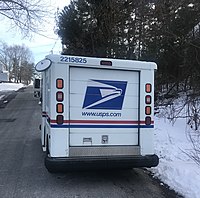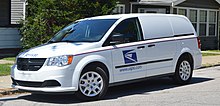Grumman LLV
| Grumman Long Life Vehicle | |
|---|---|
 A 1989 Grumman LLV of the United States Postal Service, seen in Carson City, Nevada, in December 2005. | |
| Overview | |
| Manufacturer | Grumman |
| Also called | USPS Mail truck |
| Production | 1987–1994[1] |
| Assembly | Montgomery, Pennsylvania |
| Body and chassis | |
| Class | Mail truck |
| Related | KurbWatt, Kubvan |
| Powertrain | |
| Engine |
|
| Transmission | 3-speed GM TH180 automatic[2] |
| Suspension | |
| Front | 54.1 in (1,370 mm)[3] |
| Rear | 63 in (1,600 mm)[3] |
| Dimensions | |
| Wheelbase | 100.5 in (2,550 mm)[3][4] |
| Length | 175.5 in (4,460 mm)[3] |
| Width | 75 in (1,900 mm)[3] |
| Height | 85 in (2,200 mm)[3] |
| Curb weight | 2,700 lb (1,200 kg) |
| Chronology | |
| Predecessor | Jeep Dispatcher |
| Successor | Oshkosh NGDV |
The Grumman Long Life Vehicle (LLV) is an American light transport truck model, designed as a mail truck for the United States Postal Service, which is its primary user. It is also used by Canada Post.
History[]
The Grumman LLV was specifically designed for the United States Postal Service; Grumman won the contract to produce it. The main design points of the vehicle in contract competition were serviceability, handling in confined areas, and overall economical operation. As its name suggests, the Grumman LLV is easily capable of a long life, perhaps approaching 20 years of operation. The lifespan specified by the U.S. Postal Service was 24 years, but in 2009 this was extended to 30 years. The majority of LLVs have been on the road for over 27 years. The body and final assembly is by Grumman, and the chassis (based on the 1982 Chevrolet S-10 Blazer) is made by General Motors, with the powerplant (2.5L I-4 TBI "Iron Duke" and, in later production, General Motors 2.2L I-4 iron block/aluminum head engine), instrument cluster and front suspension similar to those used in the Chevrolet S-10 pickup and Chevrolet S-10 Blazer sport utility vehicle.[5]
Overview[]
In the United States, the Grumman LLV is the most common vehicle used by letter carriers for curbside and residential delivery of mail, replacing the previous standard letter-carrier vehicle, the Jeep DJ-5. Curbside delivery from a driver seated in a vehicle to a curbside mailbox is sometimes termed "mounted delivery", in contrast to walking delivery.[6] The Grumman LLV entered service in 1987. The USPS bought over 100,000 of these vehicles, the last one in 1994.[1] Approximately 140,000 LLVs are in the USPS delivery fleet.[7][8] A number were also sold to Canada, Mexico, and several other countries.[citation needed]
Like the older postal-service Jeep DJ-5, the Grumman LLV features a right-hand drive (RHD) configuration, in contrast to the typical left-hand drive (LHD) position of vehicles in North America. It also features a large metal tray, which is able to hold three trays of letter mail, mounted where a passenger seat would normally be. This arrangement positions the driver on the side of the vehicle closest to the curb, enabling the carrier to easily grab sorted mail and place it into mailboxes without having to leave the seat. Other notable features are an exceptionally tight turning radius[9] and a low-geared, 3 speed transmission[2] for hauling heavy cargo. The LLV has a 1,000-pound (450 kg) cargo capacity.[1]
The Grumman LLV's average EPA fuel economy is 17 miles per US gallon (14 L/100 km) [16 miles per US gallon (15 L/100 km) in the city/18 miles per US gallon (13 L/100 km) on the highway].[2] In actual use by the USPS, which includes extensive stop-and-go driving for residential delivery, average fuel economy is about 10 miles per US gallon (24 L/100 km).[10] Like other U.S. Postal Service vehicles before it, the Grumman LLV lacks license plates and instead uses a seven digit U.S. Postal Service serial number, usually starting with 020, 021, 120, 125, 126, 220, 221, 330, 331, 430, 431, 720, 820, 821, 920, or 921. The first digit of the serial number represents the last digit of the year in which it was made.

The front fascia of a Grumman LLV

A Grumman LLV of Canada Post, seen here in Montreal, Quebec, in June 2010.

Grumman LLV in Concord, NH in 2017

Grumman LLV in Massachusetts, seen in 2020
Replacements[]

Because the United States Postal Service owns over 100,000 Grumman LLVs, of which the oldest are reaching the end of their lifespan, the USPS has been looking into replacing or retrofitting the LLVs. In fiscal year 2009, the USPS spent $524 million to repair its fleet of Grumman LLVs, and estimated that it would cost $4.2 billion to replace the entire fleet.[11]
The LLVs also suffer from a number of design flaws including lack of air conditioning and a heater prone to breaking down. The wheels and suspension are not suited for the all-terrain and all-weather needs of delivering mail and require snow chains during inclement weather.[12] Also, because the windshield fluid line is above the fusebox,[13] LLVs are prone to catching fire, with 42 fires reported in 2017 alone.[14][15] According to documents obtained in 2020 via a Freedom of Information Act request as part of a Vice Media investigation, 407 LLVs have been damaged or destroyed since May 2014.[16]
In some areas, LLVs have been replaced with vans and minivans, including the Dodge Grand Caravan and Dodge Ram ProMaster,[8] which tend to be much more comfortable for postal workers, especially in extreme climates.
In 2014, the USPS reviewed options for replacement.[17] The Office of Inspector General found that the Postal Services' acquisition plan for replacements lacked details and while the USPS could continue deliveries until 2017, there were concerns over the aging vehicles.[17]
Canada Post also adopted the Grumman LLV, but around 2008, it began studying whether to refurbish, upgrade, or replace its fleet. On March 18, 2010, Canada Post and Ford Motor Company announced that Canada Post would purchase a fleet of Transit Connect vans.[18]
The LLV has a unique footprint. The front wheels (taken from the two-wheel-drive S-10 Blazer model) have narrower spacing than the rear wheels (using the rear axle from the four-wheel-drive S-10 Blazer model). The front of the vehicle also has low ground clearance. While this has advantages, there are some trade offs. The vehicle was tested successfully in warmer climates, but when used in places with substantial snowfall, they became difficult to control and were poorly adapted to those conditions.[19]
On January 20, 2015, the USPS released solicitation RFI-NGDV for the Next Generation Delivery Vehicle.[20] Potential bidders had until March 5, 2015 to submit comments and pre-qualification responses. The USPS was to then select companies to receive the RFP for prototype development. On February 13, 2015, it was announced that General Motors was actively pursuing this new contract, which would have them provide the USPS with 180,000 new vehicles at a cost of at least $5 billion.[21] On September 22, 2016, the United States Postal Service awarded the NGDV Prototype Contract to six selected suppliers: AM General, Karsan, Mahindra, Oshkosh, Utilimaster, and a joint-venture bid involving Workhorse and VT Hackney. Half of the prototypes will feature hybrid and new technologies, including alternative fuel capabilities. The prototypes will represent a variety of vehicle sizes and drive configurations, in addition to advanced power trains and a range of hybrid technologies.[22]
On February 23, 2021, USPS announced that Oshkosh Defense has been awarded the contract for design and manufacture of the Next Generation Delivery Vehicle (NGDV), delivering up to 165,000 over a 10-year period.[23][24][25]
References[]
- ^ Jump up to: a b c Argonne National Laboratory. "Nation's Largest Alternative-Fuel Fleet Delivers the Goods for the U.S. Postal Service" (PDF). U.S. Department of Energy. Retrieved January 8, 2014.
- ^ Jump up to: a b c 1988 Grumman Allied Industries LLV
- ^ Jump up to: a b c d e f "LLV Postal Trucks". Grumman Memorial Park. Retrieved January 8, 2014.
- ^ Idaho National Laboratory. "All-Electric Conversion of the USPS Long Life Vehicle (LLV)" (PDF). U.S. Department of Energy. Retrieved January 8, 2014.
- ^ Preston, Benjamin (21 February 2015). "What can stop US Postal Service trucks? The inexorable march of time". The Guardian. Retrieved 26 March 2021.
- ^ Righter, T.L. "Restructuring the Postal Service for the 21st Century". postalmag.com (an independent site and is not affiliated with the USPS, its labor unions, or any other postal organizations.). Retrieved 12 October 2014.
Mounted delivery is on average 50% more efficient than walking door to door.
- ^ Reed, Matthew P.; Satchell, Kristy; Nichols, Aris. "2005-01-2675. Application of Digital Human Modeling to the Design of a Postal Delivery Vehicle" (PDF). University of Michigan Transportation Research Institute/Society of Automotive Engineers. Retrieved January 8, 2014.
- ^ Jump up to: a b Herr, Phillip; Turner, Kathleen (Assistant Director); et al. (May 2011). Report to Congressional Requesters: UNITED STATES POSTAL SERVICE: Strategy Needed to Address Aging Delivery Fleet (PDF) (Report). Washington, D.C.: Government Accountability Office. GAO-11-386. Retrieved 19 August 2020.
- ^ Pope, Nancy A. (July 11, 2010). "Long Life Vehicle (LLV)". Postal Museum Blog. National Postal Museum, Smithsonian Museum. Retrieved January 8, 2014.
- ^ "Too Costly to Keep On Truckin?". U.S. Postal Service Office of Inspector General (USPS OIG). 18 June 2010. Retrieved 12 October 2014.
The first LLVs were produced in 1987, and they average about 10 miles per gallon.
- ^ O'Keefe, Ed (June 18, 2010). "Postal service in a bind on upkeep of vehicle fleet". The Washington Post. p. B3.
- ^ Brandt, Eric (September 21, 2017). "Here's What It's Like to Drive a Grumman LLV Mail Truck Every Day". Retrieved April 25, 2021.
- ^ "Archived copy". Archived from the original on 2019-01-30. Retrieved 2019-05-31.CS1 maint: archived copy as title (link)
- ^ https://www.postaltimes.com/2017/01/2017-llv-fires/
- ^ "Postal Vehicle Fires". www.postaltimes.com. Archived from the original on 2019-11-01.[dead link]
- ^ Gordon, Aaron (7 July 2020). "Post Office Delivery Trucks Keep Catching on Fire". Vice. Retrieved 7 July 2020.
- ^ Jump up to: a b "Delivery Vehicle Fleet Replacement Report Number DR-MA-14-005" (PDF). U.S. Postal Service Office of Inspector General (USPS OIG). 10 June 2014. Retrieved 12 October 2014.
- ^ Ford Motor Company Press Release, "Canada Post Selects Ford Transit Connect to Replace Aging National Fleet of Light Vehicles," Archived 2010-07-19 at the Wayback Machine 18 March 2010.
- ^ Pope, Nancy A. (January 2009). "Long Life Vehicle Object Spotlight". National Postal Museum, Smithsonian Museum. Retrieved July 10, 2020.
- ^ "Request for Information and Prequalification/Sources Sought - Next Generation Delivery Vehicle (NGDV) Acquisition Program" 20 January 2015
- ^ Ungarino, Rebecca. "Postal service seeks to retire the old mail truck". CNBC.com. CNBC. Retrieved 14 February 2015.
- ^ "USPS Statement on Next Generation Delivery Vehicles Prototype Selection and Request for Proposal for Commercial Off-the-Shelf Delivery Vehicles". usps.com. USPS. 16 September 2016. Archived from the original on 2016-09-30. Retrieved 3 February 2017.
- ^ "U.S. Postal Service Awards Contract to Launch Multi-Billion-Dollar Modernization of Postal Delivery Vehicle Fleet - Newsroom - About.usps.com". about.usps.com. Retrieved 2021-02-23.
- ^ Beresford, Colin (2021-02-23). "USPS Chooses Oshkosh Defense to Replace Its Mail-Delivery Trucks". Car and Driver. Retrieved 2021-02-23.
- ^ "Oshkosh Defense to build U.S. Postal vehicles; Workhorse shares slide". finance.yahoo.com. Retrieved 2021-02-23.
External links[]
| Wikimedia Commons has media related to Grumman LLV. |
- "Long Life Vehicle (LLV)" by Nancy Pope at the Smithsonian's National Postal Museum blog
- United States Postal Service
- Rear-wheel-drive vehicles
- Trucks
- Grumman vehicles



